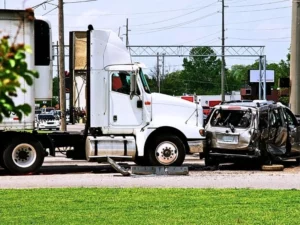Accidents involving large trucks are some of the deadliest in America. In 2014, nearly 438,000 large trucks were involved in crashes across the United States. These accidents claimed the lives of 3,903 motorists, pedestrians, and truck drivers. Nationally, 8.3% of all fatal accidents involve semi-trucks, motor homes, and other “large trucks.”

Of those who died in accidents involving large trucks, 73% were the drivers or occupants of the smaller vehicles they struck; only 17% were the drivers or occupants of the large truck. Slightly less than 10% were pedestrians or cyclists who had absolutely no protection when the accident occurred. Fortunately, the number of pedestrians and cyclists killed in 2014 declined 12% from the number killed in 2013.
In addition to fatalities, accidents involving large trucks cause a tremendous number of serious injuries. In 2014, roughly 111,000 people were injured in accidents involving large trucks. These injuries included broken bones, lacerations, contusions, concussions, burns, and spinal cord injuries. This was a 17% increase of the approximately 95,000 individuals who were injured in 2013.
Moreover, drivers and occupants of other vehicles are increasingly at risk of being injured if they are involved in an accident with a large truck. From 2013 to 2014, there was a 19% increase in the number of drivers and occupants of passenger vehicles who were injured in large truck collisions. In 2013, 69,000 were injured, and in 2014, 82,000 were injured. Thus, even while vehicle safety technology advances, it’s clear that it is doing little to protect drivers when they are involved in these types of collisions.
Trucks are more likely to be involved in multiple-vehicle crashes that lead to fatalities. 81% of large vehicle crashes leading to fatalities involve multiple vehicles. For comparison, only 59% of multi-vehicle crashes involving passenger vehicles lead to fatalities.
Among the most dangerous types of collisions involving large trucks are head-on collisions. In accidents involving a passenger vehicle and a large truck, 45% are caused by a head-on collision. In 10% of fatal accidents, the passenger vehicle was struck on its side as it turned either right or left. A further 9% occurred when both the truck and the passenger vehicle were negotiating a curve which resulted in the vehicles colliding on their side. In many cases, this led to the smaller vehicle becoming sandwiched beneath the semi-truck.
Surprisingly, trucks are 3 times as likely to be “rear ended” as passenger vehicles. Nearly 21% of crashes involved motorists striking the large truck from the rear. In only 7% of accidents did the large truck strike a passenger vehicle from the rear.
A relatively small 25% of fatal accidents involving large trucks occurred on the interstate. The vast majority, approximately 61%, occurred on rural roads. The sharp difference can be attributed to smaller roads, lack of signage, and poor visibility among other factors. Almost 79% of all accidents occurred during the weekday. Of these, 79% occurred between the hours of 6 in the morning to 6 in the evening when most motorists are on the roads.
Approximately 71% of accidents involving large trucks on weekdays occur during daylight hours. This number reverses on the weekend when 63% occur during the night. Thus, the weekday from dawn until dusk, and the weekend from dusk until dawn are the most dangerous times for motorists to be on the road.
14.9% of truck drivers who have been involved in a fatal crash had a history of recorded crashes. 16% of semi-truck drivers had at least one previous conviction for speeding, and roughly 8.9% had a history of suspensions of revocations. Only 0.3% had previous convictions for DWI or DUI.
2% of crashes involved large truck drivers who had a Blood Alcohol Concentration of .08 or higher at the time of the crash. This rate has remained relatively steady since 2005 and shows that strict enforcement is having a positive impact on the number of large truck accidents caused by alcohol.
In Illinois in 2014, there were 1,277 vehicles involved in fatal crashes. Of these, 9% involved crashes with large trucks. This is 0.7% higher than the national rate. These accidents caused 111 deaths that year. Of those who died, 81 were occupants of the other vehicle. This was the 10th highest rate in the nation. 12 were pedestrians or cyclists, which made Illinois the 8th most dangerous state for this demographic. The remainder were truck drivers or occupants of the large truck itself.
Individuals who have been involved in a serious accident should consult with a Chicago truck accident attorney to discuss their legal options. These options may include filing claims for personal injuries, pain and suffering, medical expenses, and lost wages. If the accident led to the death of a loved one, it may also be possible to pursue a wrongful death claim.







